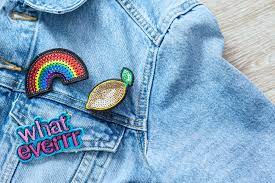
Sometimes, you might get uncertain while choosing iron-on or sew-on patches. Making the long story short, no matter you have iron-on or sew-on patches, sewing a patch is truly recommended.
Always buy a patch while thinking of stitching in your mind because sewing a patch is long-lasting and adds charm to your outfit. Let’s have a quick view of what iron-on and sew-on patches are:
What is an Iron-On Patch?
Patches with a sticky back and a glued sheet are known as iron-on patches to stick with an iron. While applying heat with an iron, the glue melts and adheres to the cloth that enables the patch to be placed firmly.
What is a Sew-On Patch?
Simple embroidered patches are known as sew-on patches; they will give a flexible look while touching as compared to iron-on sticky patches. Iron-on patches are more stubborn than sew-on patches, and they hardly bend as the fabric folds. However, you don’t need to be worried about placing your patch because you can apply them anywhere you want.
Let’s find out some significant differences between Iron-on patch and sew-on patch.
Iron-On Patch Vs. Sew-On Patch
Starting from the beginning, the iron-on patch has a sticky back with a backing sheet that sticks on the cloth after applying heat. In contrast, a sew-on patch usually has embroidered work using thread and fabric.
An Iron-on patch gives a cloudy look, while a sew-on patch looks like fabric. The glued layer on the back of the patch is responsible for giving a cloudy look.
Both patches use different items to be completed, but you cannot name a patch without examining it. They have differences in the manufacturing procedure as well.
If you are unable to differentiate between iron-on and sew-on patches, read on the package to find out which patch it is. If the box does not clear immediately, you can iron the patch on the cloth; if it does not stick, you will find out that it is a sew-on patch.
Note: After ironing the patch, you should not use hot water or a dryer at high temperatures. Using cold water can help fix it quickly and firmly, or you can hang the outfit to let it set on its own.
What is the Better Approach? Iron-On or Sew-On?
Whether you have iron-on patches or sew-on patches for permanent hold and security, sewing a patch is the best way. Iron-on patches are feasible and convenient, indeed. However, iron-on patches come up with lots of damage in contrast to sewn patches.
Ironing a patch is a redundant procedure, which is not suitable for all kinds of fabrics. Not only this, but you also have to secure the clothes from other heating sources. Besides, these patches are not flexible and durable as they tend to fall off after a limited number of washes.
Unlike iron-on patches, sewing a patch lets you free from taking extra care of the clothes. The Sew-on patch gets stick so firmly that you cannot imagine the longevity period. You can use both patches side by side according to the need. When having an iron-on patch, you are free to use both sticking methods. On the contrary, if you have a sew-on patch, you cannot iron it to stick because there is not glued layer to fix on the clothes.
If you have a choice, go for a sewing method because it will increase your patch’s life.
Note: If you want to remove the iron-on patch from your jeans, apply some heat and slowly peel off the patch to unfix. You can place another patch on it as per your choice.
How Long Iron-on Patch last?
Keep in mind that heating is the main element to fix or unfix a patch from the clothing. Iron-on patches use a backing sheet that has a glued layer to stick. If you consistently expose the patch to heat, it will no longer stay and fall off soon.
Well, your jeans will be washed very often, which makes them vulnerable to dry the glue and loosen its hold on the garment. Putting your jeans into the dryer frequently will make it unfix very soon. However, you cannot find an exact time when your patch will fall off.
Note: Avoid using iron-on patches to stick on vinyl or leather because heating is not suitable for both fabrics.
Sewing on Iron-On Patches
You can avoid all these problems by SEWING.
Sewing on an iron-on patch is the best solution to get rid of all sticky issues. Some patches have disgusting glue that does not fade away even after removing the patch. Also, these patches are not for permanent use. You can follow these two options:
- If you consider durability as an issue, sewing on an iron-on patch is the best thing to do. Sewing an iron-on patch is not possible with a regular needle. You need a solid needle for this. You can even stick the patch by ironing and sew it afterward to make it more durable and robust.
- If you want to use the patch differently somewhere else, you cannot reuse the iron-on patch after removing it. On the other side, the sew-on patch is easy to reuse anywhere simply by opening the stitches. Sew-on patch does not leave a mark in contrast to iron-on patch.
To Sum Up
Buying iron-on patches give more options as you can fix them by ironing or sewing at the same time. Iron-on patches are more flexible in terms of usage. You can iron these patches for a quick fix, and later on, for permanence, you can sew them on, while sew-on patches can be sewn only.